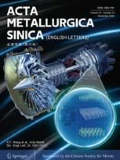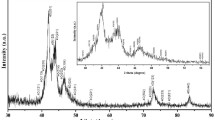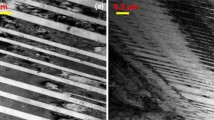Abstract
The effect of γ-phase on two-way shape memory effect (TWSME) of polycrystalline Ni56Mn25-x Co x Ga18.9Gd0.1 alloys was investigated. The results show that an appropriate amount of ductile γ-phase significantly enhances the TWSME. The largest TWSME of 1.4% without training is observed in Ni56Mn21Co4Ga18.9Gd0.1 alloy, and this value is increased to 2.0% after thermomechanical training. The as-trained TWSME decays over the first five thermal cycles and then reaches a stable value as the number of cycles further increasing. Only the degradation of 0.2% is observed after 100 thermal cycles. The better TWSME and thermal stability are ascribed to the stable extra stress field formed by the plastically deformed γ-phase.
Similar content being viewed by others
1 Introduction
Shape memory alloys (SMAs) have been successfully used in a variety of technical areas for their unique abilities such as damping characteristics, shape memory effect (SME), pseudo elasticity, etc. In various properties of SMAs, two-way shape memory effect (TWSME) is the most suitable one to be applied in actuators. TWSME means the SMAs are able to “remember” a geometrical shape at high temperature (above A f ) and another shape at low temperature (below M f ), and during the repeated heating and cooling, the SMAs change their shape between these two shapes without resetting force. To date, Ti–Ni alloy is widely researched in SMAs actuators, and the outstanding TWSME makes it exhibit excellent performance in practical application [1, 2]. However, the transformation temperature of Ti–Ni alloy is less than 100 °C, leading to the Ti–Ni actuators cannot be used in high-temperature environment. Therefore, the development of high-temperature shape memory alloys (HTSMAs) will become a research focus in the actuator field.
Currently, Ni–Mn–Ga alloys have attracted more and more interests for their high-transformation temperature, large SME and high stability [3,4,5,6,7,8,9]. The prominent performance in the high-temperature environment makes Ni–Mn–Ga alloy possible to become an excellent candidate for high-temperature actuators. Meanwhile, the TWSME has also been observed in Ni–Mn–Ga thin films and bulk single crystals [10,11,12,13,14]. In practical applications, polycrystalline alloys have an advantage over thin film and single crystals because of their easy preparation. However, there is few reported study of TWSME for polycrystalline Ni–Mn–Ga HTSMA. It is well known that the second phase in some polycrystalline SMAs like Ti–Ni [15] and Cu–Zn–Al [16] can obviously affect their TWSME. Thus, to study the effect of second phase on TWSME of Ni–Mn–Ga alloys is necessary.
The second phase with different characteristics can be introduced in Ni–Mn–Ga alloys by different forth-element addition. For example, both the additions of elements of B and Gd can introduce hard-brittle second phase [6, 9]. In contrast, the elements such as Co, Cu and Cr lead to the formation of ductile γ-phase [8, 17, 18]. Our previous study proved that the hard-brittle second phase can improve TWSME of polycrystalline Ni–Mn–Ga HTSMAs, and the TWSME of 3.5% was observed, and this TWSME remained at 2.5% after 50 thermal cycles [19]. Nevertheless, the influence of ductile γ-phase on TWSME of polycrystalline Ni–Mn–Ga HTSMAs has not yet been studied. In this paper, the soft gamma-phase is formed through the Co element doping, and the TWSME of polycrystalline Ni56Mn25-x Co x Ga18.9Gd0.1 HTSMAs is investigated.
2 Materials and Methods
The nominal compositions of the alloys studied were Ni56Mn25−x Co x Ga18.9Gd0.1 (x = 1, 2, 4 and 8). High-purity nickel, manganese, cobalt, gallium and gadolinium, with a purity level of 99.99, 99.7, 99.99, 99.99 and 99.99%, were melted in a non-consumed vacuum arc furnace under argon atmosphere for preparing alloys. The ingots were remelted eight times to ensure homogeneity. The samples were annealed in vacuum quartz tubes at 800 °C for 24 h then quenched into ice water.
XRD measurements were performed by Rigaku D/max-rB with CuK α radiation. The microstructures were surveyed by MX2600FE scanning electron microscopy (SEM). The martensitic transformation temperatures were determined by differential scanning calorimetry (DSC) with heating and cooling rate of 20 °C/min. The SME and TWSME were studied by compressive tests in the universal mechanical testing machine. The samples’ dimension and deformation rate were Φ 3 mm × 5 mm and 0.2 mm/min, respectively. The heights of the samples were measured before loading (L 0), after loading (L 1), after unloading (L 2), after heating (L 3) and after cooling to room temperature (L 4) by a micrometer with an accuracy of 0.01 mm. The pre-strain during compression was defined as ε pre = (L 0−L 1)/L 0 × 100%. The SME and TWSME were obtained as: (L 3−L 2)/L 0 × 100% and (L 3−L 4)/L 0 × 100%, respectively. Two-way shape memory training [20] experiment was conducted by thermomechanical cycles. A constant compressive strain was applied to the samples at room temperature (martensitic state). After deformation, the compressive samples were heated to the temperature above A f (training temperature) for complete shape recovery and then cooled to room temperature. At each test, the above steps were repeated for 10 times.
3 Results and Discussion
Figure 1 shows the secondary electron images of the Ni56Mn25−x Co x Ga18.9Gd0.1 (x = 1, 2, 4 and 8) alloys observed by SEM. Figure 1a shows that the Ni56Mn24Co1Ga18.9Gd0.1 alloy exhibits single-phase features of the martensite characterized by typical lamellar twin structures. When the Co content is at 2%, the second phase with granular shape uniformly disperses among the martensitic variants (Fig. 1b). The size and volume ratio of the second phase increases with the Co content increasing as shown in Fig. 1c and d, and some parts of the second phase join together to form slender bars and irregular islands. Figure 1e shows the X-ray diffraction patterns of Ni56Mn25−x Co x Ga18.9Gd0.1 alloys, and the matrix is indexed as non-modulated tetragonal-structured martensite (T), and the second phase is face-centered cubic γ-phase.
In order to confirm the thermomechanical training temperature, the martensitic transformation temperatures are measured by DSC, and the results are exhibited in Fig. 2. The Ni56Mn25−x Co x Ga18.9Gd0.1 (x = 1, 2, 4 and 8) alloys display typical one-step thermoelastic martensitic transformation. The inverse martensitic transformation finishing temperatures (A f ) are 482, 510, 514 and 452 °C, respectively. When the Ni–Mn–Ga alloys are deformed, the A f temperature will be increased for dozens of degrees [19]. This phenomenon is attributed to the fact that plastic deformation relaxes the elastic strain energy stored during thermoelastic martensitic transformation, leading to a decrease in the driving force of the martensitic reverse transformation. Therefore, the training temperature of 600 °C is selected in order to complete inverse martensitic transformation.
The compressive test results prove that the mechanical properties of Ni56Mn25−x Co x Ga18.9Gd0.1 alloys are significantly enhanced by γ-phase formation. The compressive fracture strains of dual-phase Ni56Mn25−x Co x Ga18.9Gd0.1 (x = 2, 4 and 8) alloys can reach 20, 52 and 75%, respectively. It is worth noting that mono-phase Ni56Mn24Co1Ga18.9Gd0.1 alloy exhibits poor TWSME less than 0.5%, and an appropriate amount of ductile γ-phase improves TWSME. Figure 3 shows the strain recovery characteristic curves of Ni56Mn25−x Co x Ga18.9Gd0.1 (x = 2, 4 and 8) alloys under the pre-strains of 6 and 8%. The blue arrows represent recovery strain (SME) after being heated to 600 °C for 1 min, and the purple arrows represent TWSME. It can be seen that the SME decreases with the amount of γ-phase increasing. After the shape recovery is completed, the compressive samples were shortened again with a reduction in temperature, exhibiting the characteristic of TWSME. Although the larger SME is obtained under the pre-strain of 8%, the larger TWSME is measured under the pre-strain of 6%. With the Co content increasing, the TWSME increases and reaches a maximum value of 1.4% for x = 4, and then decreases.
Ten thermomechanical training cycles are carried out on Ni56Mn25−x Co x Ga18.9Gd0.1 (x = 2, 4 and 8) alloys. Figure 4 shows the effect of thermal cycle number on the TWSME. During the first thermal cycle, the TWSMEs of the as-trained alloys are 1.9, 2.0 and 1.3%, respectively. It can be concluded that thermomechanical training enhances the TWSME. The TWSME of the as-trained alloy decreases rapidly in first several cycles and then slowly reaches a stable value as the number of cycle increases further. The degradation of the TWSME can be explained by a continual change in the dislocation configuration during thermal cycling, thereby continuously increasing the amount of unfavorably oriented martensite [21].
It is worth noting that the TWSME of the as-trained Ni56Mn21Co4Ga18.9Gd0.1 alloy reaches a stable value of 1.8% after only five thermal cycles. Although its TWSME is less than that of Ni54Mn25Ga20.7Gd0.3 alloy with hard-brittle second phase [19], the degradation (0.2%) and cycle number for stable TWSME are far less than that of Ni54Mn25Ga20.7Gd0.3 alloy, indicating that the thermal stability of TWSME for Ni56Mn21Co4Ga18.9Gd0.1 alloy is better.
The improvement of TWSME by γ-phase and the good thermal stability of as-trained dual-phase alloys can be explained as Fig. 5. Thermal martensitic variants display typical self-accommodating morphology, and these variants are replaced by preferred orientation martensitic variants after training, meanwhile, the plastic deformation is occurred in the soft particle of γ-phase, causing the formation of extra stress field (gray area). In the training process, certain amounts of useful dislocations are introduced. The internal stress field (yellow area) is formed by these dislocations, superposing the extra stress field around γ-phase to enhance the TWSME of Ni56Mn21Co4Ga18.9Gd0.1 alloy. Because the extra stress field introduced by deformed γ-phase is stability, the decay of TWSME is rarely. With the further increase of Co content, the excessive amounts of γ-phase damages SME and TWSME.
4 Conclusion
The soft γ-phase particles can improve the value and stability of TWSME due to its stable deformation stress field. The TWSME of Ni56Mn21Co4Ga18.9Gd0.1 alloy is enhanced from 1.4 to 2.0% through thermomechanical training, and this TWSME remains at 1.8% after 100 thermal cycles.
References
Z. Balak, S.M. Abbasi, Mater. Design 32, 3992 (2011)
Y.N. Liu, Y. Liu, J. Van Humbeeck, Acta Mater. 47, 199 (1998)
Y.Q. Ma, C.B. Jiang, Y. Li, H.B. Xu, C.P. Wang, X.J. Liu, Acta Mater. 55, 1533 (2007)
V.A. Chernenko, E. Cesari, V.V. Kokorin, I.N. Vitenko, Scr. Metall. Mater. 33, 123 (1995)
X. Zhang, J.H. Sui, Z.Y. Yang, X.H. Zheng, W. Cai, Mater. Lett. 123, 250–253 (2014)
X. Zhang, Q.S. Liu, X.S. Zeng, J.H. Sui, W. Cai, H.B. Wang, Y. Feng, Intermetallics 68, 113 (2016)
Y. Xin, Y. Li, L. Chai, H.B. Xu, Scr. Mater. 57, 599 (2007)
S.Y. Yang, Y.Q. Ma, H.F. Jiang, X.J. Liu, Intermetallics 19, 225 (2011)
X. Zhang, J.H. Sui, X.H. Zheng, Z.Y. Yang, W. Cai, Mater. Sci. Eng. A A597, 178 (2014)
V.V. Kokorin, V.A. Chernenko, Phys. Met. Metall. 68, 111 (1989)
M. Ohtsuka, M. Matsumoto, K. Itadaki, J. Intel. Mat. Syst. Str. 17, 1069 (2006)
W.H. Wang, G.H. Wu, J.L. Chen, C.H. Yu, S.X. Gao, W.S. Zhan, Z. Wang, Z.Y. Gao, Y.F. Zheng, L.C. Zhao, Appl. Phys. Lett. 77, 3245 (2000)
J.D. Callaway, R.F. Hamilton, H. Sehitoglu, N. Miller, H.J. Maier, Y. Chumlyakov, Smart Mater. Struct. 16, 108 (2007)
V.A. Chernenko, E. Villa, S. Besseghini, J.M. Barandiaran, Phys. Proced. 10, 94 (2010)
H. Scherngell, A.C. Kneissl, Acta Mater. 50, 327 (2002)
X.M. Zhang, J.M. Guilemany, J. Fernandez, M. Liu, L. Liu, Intermetallics 8, 703 (2000)
J.M. Wang, H.Y. Bai, C.B. Jiang, Y. Li, H.B. Xu, Mater. Sci. Eng. A 527, 1975 (2010)
Y.Q. Ma, S.L. Lai, S.Y. Yang, Y. Luo, C.P. Wang, X.J. Liu, Trans. Nonferr. Met. Soc. China 21, 96 (2011)
J.H. Sui, X. Zhang, X.H. Zheng, Z.Y. Yang, W. Cai, X.H. Tian, Scr. Mater. 68, 679 (2013)
S. Datta, A. Bhunya, M.K. Banerjee, Mater. Sci. Eng. A A300, 291 (2001)
H. Scherngell, A.C. Kneissl, Scr. Mater. 39, 205 (1998)
Acknowledgements
This work was supported by the National Natural Science Foundation of China (No. 51601126), the Student’s Platform for Innovation and Entrepreneurship Training Program (No. 201710060118) and China Postdoctoral Science Foundation (No. 2016M601271).
Author information
Authors and Affiliations
Corresponding authors
Additional information
Available online at http://link.springer.com/journal/40195.
Rights and permissions
About this article
Cite this article
Zhang, W., Zhang, X., Wang, Q. et al. Gamma-phase influence on shape memory properties in Ni-Mn-Co-Ga-Gd high-temperature shape memory alloys. Acta Metall. Sin. (Engl. Lett.) 31, 471–476 (2018). https://doi.org/10.1007/s40195-017-0675-3
Received:
Revised:
Published:
Issue Date:
DOI: https://doi.org/10.1007/s40195-017-0675-3









